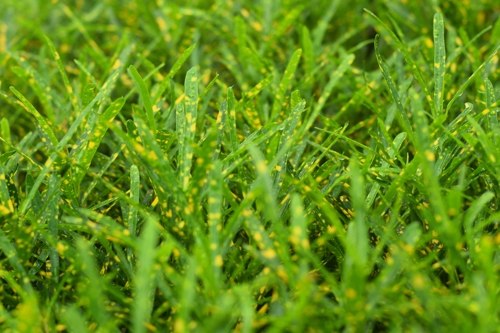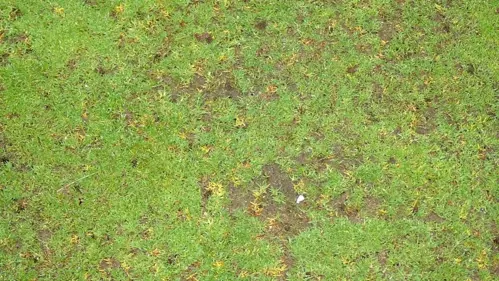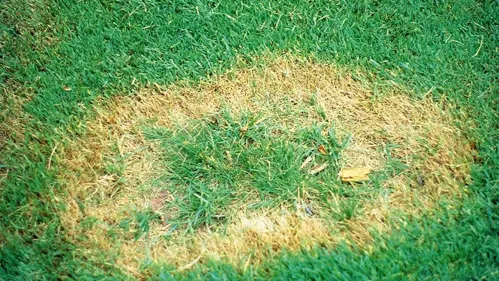Your handy guide to lawn diseases in Europe
27 Sept. 2023 Landscaping & Turfcare
Something isn't right with your client’s lawn. You know it's not just suffering from drought or overwatering, and you’re certain it’s a lawn disease – you’re just not sure exactly which one.
There are, unfortunately, quite a few different lawn diseases that could be affecting the grass. In this guide, we will help you to identify lawn diseases, learn how to treat them and prevent them from reoccurring.
An introduction to identifying, treating and preventing the most common lawn diseases in Europe
Sometimes a lawn disease is simply bad luck, but more often than not, diseases are given the opportunity to develop because of poor lawn care practices. Learning how to prevent them often goes hand in hand with the actual treatment.
We'll guide you through treatment and prevention for each of the most common lawn diseases in Europe, and help you learn how to distinguish between them.
You can either read the whole guide or navigate to the lawn disease you want to find out more about below.
Contents
1. Red thread (Laetisaria fuciformis)

Commonly found across Europe, red thread thrives in cool, moist conditions, and is most likely to appear in late summer and autumn. Poorly fertilised lawns are especially vulnerable to red thread.
How to identify red thread:
This lawn disease forms pinkish-red or tan patches on the lawn, eventually becoming brown in appearance or even bleached of all colour.
It's characterised by pink threads that extend from the tips of grass blades, giving a "red thread" appearance. Though it can also manifest as small, pink, cottony flocks in severe cases, which is often mistaken for snow mould.
How to treat it:
Applying nitrogen to the affected area will usually be enough to eliminate the problem. Nitrogen is best given as sulphate of ammonia at 15g per square metre.
It's worth noting that you shouldn't apply nitrogen after August, which is, unfortunately, a common period for red thread to develop, as nitrogen promotes soft growth which can lead to snow mould.
Careful lawn maintenance is another way to tackle red thread without the use of chemicals;
- Improve drainage and aeration, breaking up compacted soil.
- Scarify, removing thatch and moss to improve aeration.
- Maintain proper fertilisation to prevent nutrient deficiencies.
- Mow when the grass is dry to minimise disease spread and dispose of grass clippings.
How to prevent it from happening again:
A well-rounded lawn care regimen is key for healthy grass, and helps avoid any future flare-ups:
- Maintain proper fertilisation and nutrient balance, with a particular focus on nitrogen levels.
- Improve soil drainage and aeration.
- Mow when the grass is dry to prevent disease spread.
- Manage lawn cutting heights carefully. Long grass encourages fungal growth, but too short and you will weaken the natural defences of the grass plant.
- Be quick to clear leaf debris; fungal diseases spread quickly in this environment.
2. Pink snow mould or fusarium patch (Microdochium nivale)

Found throughout Europe, but more prevalent in the northern countries. Pink snow mould, also known as fusarium patch, is usually less severe and damaging than grey snow mould.
It is, as you might have guessed, a cold-weather disease that thrives in cooler temperatures, often appearing after snowmelt or in areas with excessive moisture. It typically makes an appearance in autumn, winter or early spring.
How to identify pink snow mould:
This disease appears as circular patches of tan or straw-coloured grass. In severe cases, a white or pinkish mycelium may be present on the grass blades.
These circles typically range from around 5 to 25 centimetres in diameter, starting small and getting larger as damp conditions persist.
How to treat it:
Dry weather does most of the work for you, as the mould starts to die off when damp conditions subside. Other ways to combat the lawn disease include;
- Raking the afflicted areas, removing thatch and breaking up matted grass to improve air circulation.
- Improving soil drainage, breaking up any compacted soil.
How to prevent it from happening again:
There's not much you can do to stop cold weather. But when the snow melts, you want the grass to be in the best position possible to fight off any lawn disease. You can do this by:
- Practising good mowing technique, avoiding scalping and putting unnecessary stress on the grass.
- Continuing proper lawn maintenance and mowing throughout autumn, so there won't be long grass under snow.
- Promoting good drainage; warn customers not to overwater.
- Scarify and prevent thatch build-up, increasing air circulation.
- Avoiding excessive nitrogen fertilisation. Lawn fertilisation is a careful balance; unlike red thatch, snow mould growth is encouraged by the presence of nitrogen.
- Be careful with planting grass seed in the autumn, as ungerminated seeds can lead to fungal growth.
- Select grass varieties to overseed with that are resistant to fusarium patch.
- Rake up leaves, remove piling snowdrifts and reduce snow compaction to eliminate potential breeding grounds for fungus.
- Improve sunlight penetration and combat poor air circulation in the lawn by cutting back shrubs and trees.
3. Grey snow mould (Typhula spp.)

Grey snow mould, also known as typhula blight, can be found in both northern and southern Europe, though it is more common in the north due to the prerequisite of cold weather. It usually occurs when snow cover persists for an extended period, providing a moist environment for fungal growth.
This is the more severe iteration of the two snow-related turf diseases and can become a persistent problem if left untreated.
How to identify grey snow mould:
Like fusarium patch, typhula blight creates circular patches of matted, dead grass. It is likely to first appear as yellow-tinged, dying grass that later turns brown. It's often covered with white or grey fungal growth.
Though a technically different – and more severe – lawn disease, you can treat and prevent grey snow mould in the same way as pink; refer back to the treatments and prevention methods in the previous section to get control of typhula blight.
4. Dollar spot (Sclerotinia homoeocarpa)

Dollar spot is prevalent in warmer climates, so tends to be more common in southern Europe, though it still occurs in the north. Periods of high humidity and morning dew increase the risk of dollar spot developing.
How to identify dollar spot:
This disease forms small, silver dollar-sized patches of bleached grass, which can often appear slightly sunken with reddish-brown borders. The affected grass blades develop characteristic light-tan lesions.
How to treat it:
Like most fungal lawn diseases, dollar spot thrives in damp conditions. To treat it without the use of chemicals, you can:
- Boost nitrogen levels in the soil.
- Remove excessive thatch build-up.
- Reduce the amount of watering, or request your customer to do so. If watering is needed, it must be done early in the day to allow grass blades to dry.
- Brush morning dew from the grass.
- Aeration. Improve soil drainage to prevent prolonged leaf wetness.
How to prevent it from happening again:
- Avoid low nitrogen levels and balance nutrients in the soil effectively.
- Maintain proper mowing heights to avoid placing stress on the grass.
- Ensure there is sufficient irrigation during dry spells and avoid watering in the evening.
- Clear foliage hanging over the lawn.
5. Brown patch (Rhizoctonia solani)

Brown patch is found across Europe, but is particularly likely in warmer, humid conditions; it usually appears in mid to late summer. Brown patch is one of the most severe lawn diseases and typically affects cool season grasses.
How to identify brown patch:
Also known as large patch, brown patch creates irregular circular patches of yellow or brown grass that can range from a few centimetres to one or two metres in diameter. If you look very closely, you will see tan-coloured lesions on the grass blades that have a brown border.
There may also be some light, cotton-like mycelium on the turf in certain cases.
How to treat (and prevent) it:
- The fungus likes humid conditions; aeration and dethatching improves air circulation, which will help control the disease.
- Avoid excessive fertilisation. A lighter feed is less likely to create a breeding ground for fungus.
- Early morning, infrequent irrigation.
- Reseed with resistant varieties of grass.
6. Rust (Puccinia spp.)

Found throughout Europe, this lawn disease tends to appear in late summer and early autumn when there's plenty of wet weather.
How to identify rust disease:
Rust disease is easily identifiable thanks to its distinctive reddish-brown spores. Affected areas turn yellow and the grass leaves produce orange pustules that release rust-coloured spores. Your clothes may be stained orange just by walking over a patch of grass with rust disease.
The grass eventually weakens and turns brown and wilted, but will usually survive the disease.
How to treat (and prevent) it:
- Mow the grass frequently to cut back affected grass.
- Fertilise the lawn well in summer to boost the turf's growth and vigour.
- Improve air circulation and reduce soil compaction.
- Increase sunlight penetration through proper pruning.
- Avoid drought stress by providing adequate water.
- Avoid nitrogen-heavy fertilisation in the autumn.
- Brush away morning dew, or encourage customers to do so. Rust needs several hours on damp grass to germinate.
7. Leaf Spot (Bipolaris spp.)

Leaf spot is relatively common in southern Europe, and less prevalent in northern Europe. The disease prefers humid and warm conditions, typically occurring in summer. It's important to catch leaf spot early, as it gets more difficult to control as the disease develops.
How to identify leaf spot:
Leaf spot diseases cause small, irregularly shaped brown or black spots on grass blades. They will appear very small at first and gradually increase in size. As they get larger, these lesions will develop a yellow ring or 'halo' around them.
If you're not examining the grass closely, it will generally look yellow in colour. The affected areas of grass will start to wilt, eventually dying out.
How to treat it:
- Overseed the lawn with disease-resistant grass varieties.
- Water deeply but infrequently to minimise the amount of time the grass is damp.
- Improve air circulation through proper spacing and pruning.
- Reduce thatch and aerate the lawn.
- Mow at recommended heights to reduce stress on the grass and bag clippings to prevent the disease from spreading.
How to prevent it from happening again:
- Maintain proper mowing heights and reduce thatch.
- Fertilise the lawn well, paying close attention to nitrogen levels.
- Regular irrigation in times of hot weather. Drought stress can often lead to leaf spot.
8. Pythium blight (Pythium spp.)
Pythium blight is found all over Europe but is more common in southern Europe due to warmer and humid conditions. The fungal disease can appear in cold weather, but thrives in warm and humid conditions, especially when grass remains wet overnight.
How to identify pythium blight:
Pythium blight causes small, circular patches of wilted and waterlogged grass that can quickly turn brown and die. Affected areas may have an oily feel and appearance.
There will often be a cotton-like fungal growth on turf affected by pythium blight.
How to treat (and prevent) it:
- Water in the early morning to allow grass to dry.
- Aerate the turf and reduce thatch build-up.
- Avoid excessive nitrogen fertilisation.
- Select grass varieties that are resistant to the fungus.
- Increase air circulation by pruning bushes and trees overhanging the lawn.
9. Anthracnose (Colletotrichum spp.)
Anthracnose manifests in two forms, basal rot and foliar blight. It's found across Europe, particularly in warmer regions. Basal rot develops in cool, damp conditions so is usually associated with autumn and winter. Foliar blight is more common during the summer, when temperatures are high and the grass is under greater strain.
How to identify anthracnose:
Basal rot first appears as yellowing leaves, with black rot appearing at the base.
Foliar blight creates patches of yellow grass, which is often mistaken for drought. It turns brown, eventually thinning into bare patches of dead grass.
How to treat (and prevent) it:
- Improve soil drainage and avoid compaction.
- Maintain proper mowing heights and avoid scalping; allow grass to grow slightly longer.
- Careful nutrient balance in the soil. Pay particular attention to nitrogen levels.
- Infrequent, deep watering.
- Encourage clients to brush dew from the turf in the morning.
10. Take-all patch (Gaeumannomyces graminis)
Take-all patch is present all over Europe, though it is slightly less common in the north. It's frequently associated with drought stress, and is therefore primarily a summer lawn disease.
How to identify take-all patch:
This disease creates large, irregularly shaped patches of dying grass, appearing reddish at first, then becoming brown as the disease worsens. They will often look like a circle, as other, more resistant grass varieties start to grow in the centre of the patch.
How to treat (and prevent) it:
- Improve soil drainage and aeration.
- Acidifying the soil.
- Overseeding with resistant grasses like ryegrass, fescue or smooth stalk.
- When choosing a topdressing, avoid anything alkaline (alkaline conditions promote take-all patch growth). Be careful to maintain proper soil pH and nutrient levels.
11. Fairy rings (Various fungi)

Its name might be sweet, but the lawn disease is anything but. Fairy rings can occur anywhere in Europe and often appear in lawns with significant organic matter build-up.
How to identify fairy ring:
Fairy rings can be identified through rings or arcs of dark green grass, which will become brown as the grass struggles to absorb water. These circles can be, at certain times of the year, marked with toadstools, as the fungus forms along the affected area.
How to treat (and prevent) it:
- Improve aeration, reducing soil compaction so water can reach the grass roots.
- Dethatch to reduce organic matter build-up.
- Fertilise properly to discourage fairy ring growth.
- Use a good quality topdressing on the lawn once or twice a year.
- If all else fails, digging out the soil (30cm deep) and replacing the turf is an option.
12. Slime mould (Physarum spp.)
Image: RHS, Horticultural Science
Slime mould is a relatively harmless lawn disease that can be found throughout Europe, especially during wet and humid conditions, and is most common during late summer and autumn. It's an unsightly disease for your lawn but fortunately is relatively short-lived.
How to identify slime mould:
Slimy, greyish-black pinhead-sized spores or a yellow mass on grass blades are signs of slime mould.
How to treat (and prevent) it:
- Slime mould is generally harmless and fades with time, so if you do nothing, it will disappear eventually.
- If you want to get rid of it now, simply gently wash away the slime mould with water.
- Improve air circulation and sunlight to the area to prevent it from happening again.
13. Powdery mildew (Erysiphe spp.)
Image: GoodNature Organic Lawn Care
This lawn disease can be found across Europe, though is more common in Northern areas, particularly during cool periods with plenty of wet weather. While a more common blight on plants and flowers, powdery mildew can also affect grass, so it pays to be aware of the warning signs.
Powdery mildew tends to become an issue during cool and humid conditions, and is particularly likely to affect shaded areas.
How to identify powdery mildew:
Powdery mildew first appears as white spots on grass, plants or flowers, which can be tricky to see. It evolves into a white or grey powdery growth on the lawn. It can lead to stunted growth and reduced vigour.
How to treat (and prevent) it:
- Prune overgrown plants and trees covering the lawn to increase sunlight and air circulation.
- Avoid excessive nitrogen fertilisation in shaded areas.
- Cutting heights should be slightly higher in very shaded areas to avoid stressing the grass.
- Water shaded areas of grass infrequently, but deeply, and only do so early in the day to allow it to dry before nightfall.
- Choose disease-resistant grass varieties when establishing a lawn.
Should you use fungicides to treat lawn disease?
When tackling a fungal lawn disease, it can be tempting to go straight to fungicides to remove it. But as you should now be aware, most fungal lawn diseases can be controlled without reaching for chemical treatments, which are usually harmful to the environment.
In severe cases, fungicides may be necessary against certain lawn diseases, like anthracnose or pythium blight, where they are more effective. But they should be a last resort, and if you can avoid using chemical treatments, you should.
Of course, the best thing is to prevent lawn diseases from occurring in the first place. A fungal disease needs certain conditions to thrive – if you remove those factors, many lawn diseases will be unable to take hold.
Keeping lawns healthy
With the help of this guide, you should be well-equipped to treat any lawn diseases you encounter. If handled correctly, the grass should quickly recover and leave you and your customers with a healthy lawn.
As you can see, most lawn diseases can be controlled with proper lawn maintenance. If your clients want a quick return to a healthy green lawn, you can make it happen with careful adherence to best lawn care practices.
Regular mowing and a clean cut are essential to preventing lawn stress and getting control over most lawn diseases. For high-quality equipment designed for professional lawncare, explore machinery Powered by Kawasaki.
You may be interested in
-
Die berühmtesten grünen Oasen Europas

-
Rasen vertikutieren und anschließend wieder frisch machen

-
Welches sind die grünsten Länder Europas?

-
Rasen wetterfest machen und gegen Staunässe, Frost und Trockenheit schützen

-
Landscaping trends for 2024

-
Kennen auch Sie diese Mythen rund um die Landschaftspflege?












